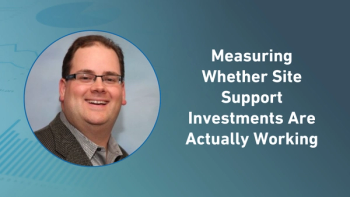Key takeaways for clinops professionals
- Consistency across multi-site operations requires clear processes, regional oversight, and safeguards to maintain culture and quality.
- Scaling staff effectively depends on structured role definitions, transparent pay scales, and pathways for upward mobility.
- Training and mentorship should balance centralized standards with site-level execution to ensure alignment and long-term staff development.
In a breakout session at the 2025 Society for Clinical Research Sites (SCRS) Global Site Solutions Summit, a panel of industry experts from the clinical trial site space discussed the challenges and strategies involved with scaling.
Moderated by Sean Stanton, co-founder, K2 Medical Research, the panel included Lisa Bjornestad, vice president of principal investigator partnerships, Tekton Research; Dawn Muscolino, director, strategic site solutions, IQVIA; Jeff Repper, chief operating officer, Rovia Clinical Research; and Amanda Wright, SVP, strategic solutions, Javara.
Maintaining culture and quality across locations
The discussion was kicked off by a question from the audience that raised how sites can effectively maintain culture and quality across different locations. In response, Bjornestad said: “One of my goals when I'm thinking about our various sites is I want it to be kind of like McDonald's. You go in, you know exactly what your fries are going to taste like.”
She continued: “I want that experience with CRAs (clinical research associates) when they come in. When they walk into one of our sites, they know it's going to be just like the other site they went to. We have 27 sites now across the US, so it becomes really challenging, and at some point, that's where you insert that regional director.”
The other members of the panel agreed with Bjornestad’s response. They also mentioned that caution should be taken when moving site staff around to different locations, as this can destabilize the main site location.
Scaling staff and roles effectively
Another member of the audience chimed in with a question regarding the rapid growth of single sites and the need to add more staff. Repper responded by explaining that it is a great challenge to have for two reasons:
- Having the opportunity to extend the capacity of a site’s director level by delegating down,
- and increasing the upward mobility of a coordinator by giving them new titles and responsibilities.
“The recommendation that I have specifically around scalability when you're going to do this is have a methodology for it: set your pay scales, set your roles and responsibilities and how they report to each other, and what are the expectations,” Repper said. “I come back behind with the tools that I'll use for performance appraisals and those kinds of things, and then start to normalize this and say that we're talking about it. ‘This is what we intend to do, this is what the timeline looks like.’”
Training and mentorship best practices
Staying on the topic of site staff management, one of the last areas the panel touched on was best practices for training. Stanton explained how his organization, K2 Medical Research, has a “bullpen” of research assistants that are constantly being brought in and trained.
“We expand by opening another site with someone that deserves it,” he said. “That's what we do. We incubate it at the RA (research assistant) level.”
Wright added: “This is from some lessons learned: you can only centralize so much when it comes to training. I think we centralize the structure from the standpoint of ‘this is how we want everybody trained,’ and there is a playbook, but you also have to pick the right people to train them at the site level.”
Muscolino, who was representing the views of a contract research organization (CRO) throughout the discussion, noted that CROs want to see mentorship happening through site-level training.
“That helps reassure us that you guys have that eye on the prize, and then making sure your staff knows what the expectations are, they're performing the expectation, and that is an ongoing process, that's not a work and done process,” she said.
Reference
Bjornestad L, Musolino D, Repper J, Stanton S, Wright A. Scaling Success: Strategies For Sustainable Growth. September 30, 2025. 2025 SCRS Global Site Solutions Summit.





